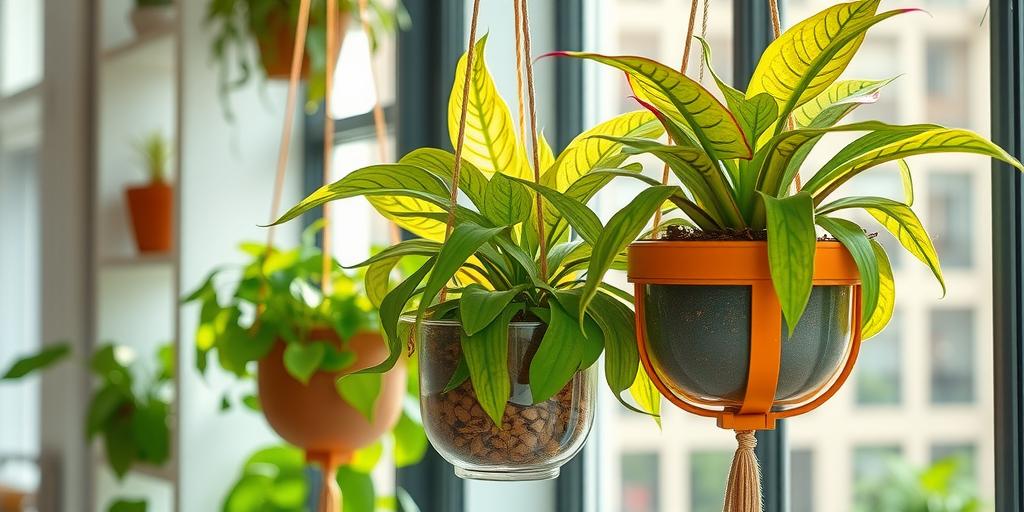
Easy to Care Hanging Plants That Thrive in Low Light
Discover the best low-light hanging plants that are easy to care for and perfect for any indoor space! From pothos to spider plants, find hardy, low-maintenance options to brighten up your home.
Introduction
Did you know that some of the most beautiful hanging plants actually prefer low-light conditions? If you’ve ever struggled to keep plants alive in dimly lit rooms, this guide is for you! Whether you’re a busy plant parent or a beginner, these easy-care hanging plants will thrive with minimal effort. No fancy grow lights needed—just simple, lush greenery to transform your space. Let’s dive in!
Why Choose Low-Light Hanging Plants?
If you live in an apartment, work in an office with limited sunlight, or just have a room that doesn’t get much natural light, low-light hanging plants are the perfect solution. These plants thrive in dimmer conditions, making them ideal for spaces where traditional houseplants might struggle.
One of the best things about low-light hanging plants is how low-maintenance they are. If you’re new to plant care or tend to forget watering now and then, these forgiving varieties won’t hold it against you. Plus, they bring a touch of nature indoors, improving air quality and adding a calming, green aesthetic to your space.
They’re also incredibly versatile—perfect for high shelves, bathrooms, or any corner that gets indirect light. No need to worry about finding the perfect sunny spot; these plants will happily grow where others wouldn’t.
Top Easy-Care Hanging Plants for Low Light
1. Devil’s Ivy (Pothos)
If you want a plant that practically thrives on neglect, Devil’s Ivy (also known as Pothos) is your best bet. This plant is nearly indestructible, making it perfect for beginners. It grows well in low to moderate light and can even survive in fluorescent office lighting.
One of its best features? The long, trailing vines that look stunning in hanging baskets. Plus, it’s forgiving if you forget to water it now and then—just let the soil dry out between waterings.
2. Spider Plant
Spider plants are another excellent choice for low-light conditions, though they do best with some indirect sunlight. They’re known for their air-purifying qualities, making them a great addition to any indoor space.
What’s fun about spider plants is how they produce little “spiderettes”—baby plants that dangle from the mother plant. You can easily propagate these to grow more plants. They’re also drought-tolerant, so if you occasionally skip a watering, they’ll bounce right back.
3. Heartleaf Philodendron
For a fast-growing, lush option, the Heartleaf Philodendron is a winner. This plant is incredibly low-maintenance and adapts well to dimly lit spaces. It’s especially happy in humid environments, making it a great choice for bathrooms.
The trailing vines add a tropical feel to any room, and since it’s so forgiving, it’s perfect for those who want greenery without the hassle. Just keep it out of direct sunlight, and it’ll thrive.
4. English Ivy
English Ivy is a classic vine that does well in shady spots, making it ideal for low-light hanging baskets. Not only does it look elegant with its cascading leaves, but it also helps reduce indoor air pollutants.
One thing to note: English Ivy can grow quickly, so occasional pruning will keep it under control. Whether you let it trail from a hanging pot or train it to climb, it adds a timeless, green touch to any space.
5. ZZ Plant (Zamioculcas zamiifolia)
If you’re looking for a plant that can survive just about anything, the ZZ Plant is it. This hardy plant thrives in low light and can go weeks without water—perfect for forgetful plant parents.
Its glossy, dark green leaves add a touch of elegance to any room, and while it grows slowly, it’s incredibly long-lasting. Just be sure not to overwater it, as it stores water in its roots and prefers to dry out between waterings.
6. String of Hearts
For something a little more delicate and unique, the String of Hearts is a beautiful trailing plant with heart-shaped leaves. While it prefers bright, indirect light, it can tolerate lower light conditions—just expect slower growth.
The key to keeping this plant happy is avoiding overwatering. Let the soil dry out completely between waterings, as too much moisture can lead to root rot. Its dainty, trailing vines make it a charming addition to any hanging planter.
Tips for Keeping Low-Light Hanging Plants Healthy
Even though these plants are low-maintenance, a little extra care can help them thrive. Here are some key tips:
-
Water sparingly – Low-light plants don’t dry out as quickly as sun-loving ones, so wait until the top inch of soil is dry before watering. Overwatering is a common mistake that can lead to root rot.
-
Rotate occasionally – If your plant is near a window, rotate it every few weeks to ensure even growth. This prevents one side from stretching toward the light.
-
Dust the leaves – Dust can block light absorption, which is especially important in low-light conditions. Wipe the leaves gently with a damp cloth every now and then.
-
Avoid over-fertilizing – Since these plants grow slower in low light, they don’t need much fertilizer. Too much can actually harm them—stick to a diluted fertilizer every few months.
-
Choose the right pot – Good drainage is crucial. Make sure your hanging pot has drainage holes to prevent water from sitting at the bottom, which can cause root rot.
By following these simple care tips, your low-light hanging plants will stay healthy and vibrant, bringing life to even the darkest corners of your home.
Conclusion
Who says you need bright sunlight to enjoy gorgeous hanging plants? With these easy-care, low-light options, you can bring life to even the darkest corners of your home. Whether you opt for a resilient pothos or an elegant ZZ plant, these green companions will thrive with minimal effort. Ready to transform your space? Pick your favorite and start hanging!
